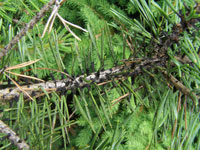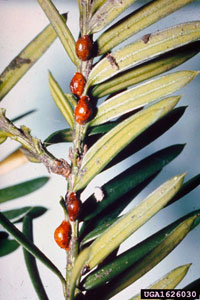Extension > Garden > Diagnose a problem > What's wrong with my plant? > Evergreen Trees and Shrubs > Yew > Blackened needles
Yew > Needles > Blackened needles
1 of 3
Sooty mold
- Black, brown, or gray soot-like covering on leaf surfaces, or twigs
- Sticky, shiny secretions on leaves from sap-sucking insects (aphids, leaf hoppers, psyllids, etc.)
- Insects or signs of insect damage (distorted, pin-prick feeding marks, etc.) may be seen on leaves above the worst affected moldy areas
- More information on Sooty mold
2 of 3
Fletcher scale
Parthenolecanium fletcheri
- Heavily infested foliage turns yellow, becomes thin as needles drop prematurely
- Honeydew is covered with sooty mold on branches, twigs and needles
- Small (1/4 inch), round, brown scales at bases of needles
- More information on Fletcher scale
3 of 3
- - NO PHOTOS AVAILABLE -
Taxus mealybug
Dysmicoccus wistariae
- Heavily infested branches cause foliage to thin
- Also covered with sticky honeydew and sooty mold
- Mealybugs are covered with white waxy secretions, up to approximately ¼ inch long
- Damage occurs in late spring









